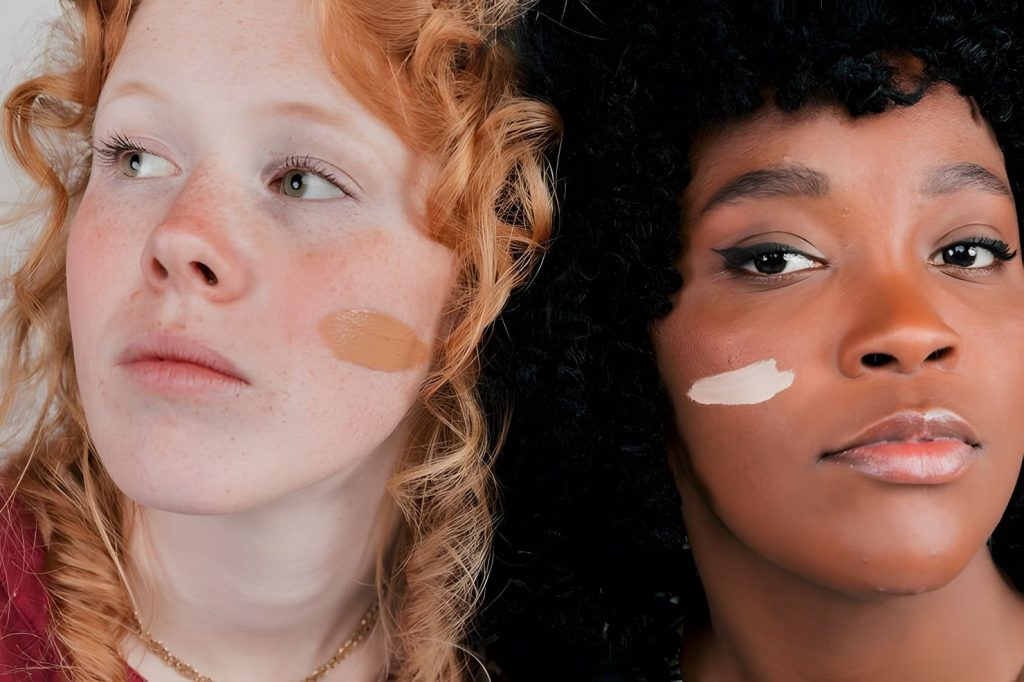Over the last few years, there have been many improvements in foundation shades (and this was long overdue). The days of choosing between only a few shades to end up with a mask-like foundation on your neck are over. The inclusive ranges of today take into account the vast array of skin tones, undertones and shades. Some brands offer foundations in at least 40 shades. You might wonder how to match the foundation to your skin tones with so many choices.
The foundations are as customizable as the coffee you order at Starbucks. This is why foundation is one of the most difficult makeup products to purchase. There are professionals who know how to do this. We asked makeup artists Allen Avendano and Daniel Martin to help us break down all the factors you should consider when choosing your next foundation.
How to Determine Your Skin Tone
Start by examining your skin tone. It can be anything from light to dark with subtle nuances. Light-medium, or very deep. Your jawline is the best way to determine your skin tone, since it can be uneven.
Find your skin’s undertones
If you don’t want to correct your skin color, do not fight the natural undertones of your skin. They can be warm, cool or neutral. You can quickly determine your undertones by looking at your veins. You have cool undertones if your veins are purple or blue. Green veins, on the other hand, have warm undertones. If you have blue-green veins on your skin, the undertones will be neutral.
If you have a warm skin tone, choose a foundation with yellow, gold or peach undertones. If your complexion is cool, you should choose a foundation shade with pink undertones. If you have neutral undertones, look for foundations with gold and pink tones.
Test Some Shades
It’s now time to try out some shades. Select the shades that are closest to your undertones and skin tone. You can either try out the color on your face, or use a swatch.
The Face Method
Martin says to “find a spot in the center of the face and blend it out toward the hairline, so that you match your cheeks down the middle and the sides.” If your neck is paler than your skin and you want to keep your face from looking as pale, pick a shade lighter.
You can always “warm up” the face using bronzer, if it still looks light. Martin says that this way, it won’t be too dark or much warmer than the neck.
The Swatches Method
There’s plenty of room to swatch foundation on your forearm. However, the skin in this area is much darker than on your face. Avendano suggests applying potential shades on your chest first to make sure they’re right. He explains that the color will change throughout the day, so it doesn’t need to be an exact match. “Foundation oxidizes as it wears and gets darker naturally with the elements and oils on your skin.”
Try taking some samples home and testing them out in natural light before making a purchase. Both makeup artists agree that it is important to test the foundations under natural light.
Calculate the coverage level you need
Once you have chosen your foundation color, you need to choose the coverage level you want. The key to choosing the best coverage for you is understanding the appearance of each level. If you have acne, discoloration or want a foundation that lasts all day without needing to be touched up in the middle, a full coverage foundation is a good choice.
Avendano suggests a sheerer foundation if you aren’t sure what coverage you require. He says he always recommends foundations with light to medium coverage, because they can be built up.
Consider Your Skin Type
Matte or dewy foundation? Before you start swatching shades of foundation, ask yourself this question. When it comes to selecting finishes, your skin type plays a big role. Martin says dewy foundations work best for normal to dry skin. He explains that too much radiance makes this skin type look even oilier, and gives a bad feeling to the face. Matte foundations work best for skin types with combination or oily tan.
Avendano suggests using a satin finish on mature skin instead of matte. He explains that “more mature skin is able to get away with matte, but just as dewy skin can highlight [fine lines] or wrinkles, matte foundations can do the same because they have no dimension.”
Adjust Your Shade to the Season
It’s a fact: You can’t stick with one foundation color all year round. Martin says that our skin tends warm up during the spring and summer when we are more active outside in direct sunlight. Even if you wear sunblock daily, your skin will warm up.
Take advantage of virtual try-on tools
It’s true that germs can be a reason to use a virtual makeup tool instead of in-store testers. Trying foundation shades at home will ensure that you get the correct shade the first time and you can see how the foundation looks in selfies. Many brands and retailers, such as L’Oreal Paris and Ulta Beauty have developed their own tools.

